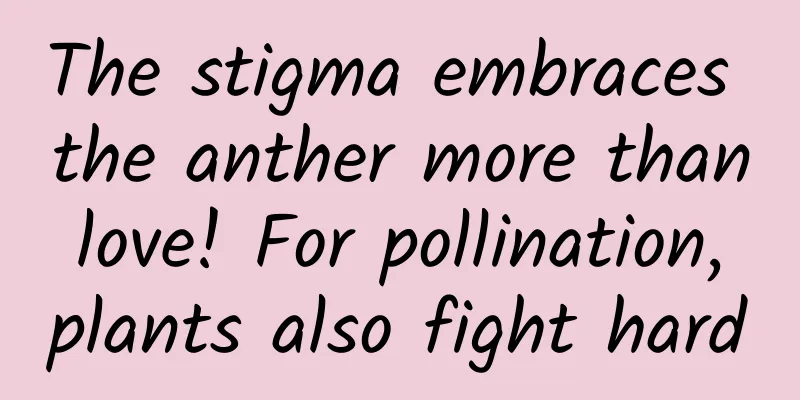The stigma embraces the anther more than love! For pollination, plants also fight hard

|
Produced by: Science Popularization China Author: Li Yin (School of Life Sciences, Sun Yat-sen University) Producer: China Science Expo Plants live in a sessile lifestyle. Most of them are quiet and do not move on their own. However, some plants can indeed produce obvious observable movements under special circumstances, such as the contraction and drooping of mimosa leaves when touched, the closing movement of insect traps, etc. The closing motion of the Venus flytrap leaf (Image source: Reference [1]) Animals use contractile muscles to change their body shape and generate movement. The main principle driving plant movement is that cells absorb or lose water, relying on hydrostatic force and osmotic pressure to make cells in some tissue layers expand or contract , thereby causing organs to undergo reversible and large-scale shape changes. These cells are called motor cells , which expand (or contract) when osmotic pressure changes to generate movement. However, people know very little about the delicate cellular mechanisms involved. The contraction movement of animal muscles and the swelling movement of plant cells (Image source: Reference [3]) So why do plants move? How do they move? Contractile cells: The secret of movement in the variegated spathiphyllum Recently, Wang Yinzheng's team from the Institute of Botany, Chinese Academy of Sciences, made new discoveries in their research on Chirita pumila, providing new insights into the cellular mechanisms within plant movement organs. The stigma of the flower of the genus Gesneriaceae is an annual herb, and the research team found that the stigma of this plant can produce a bidirectional opening and closing-bending movement, is water-sensitive, and has a circadian rhythm . Anatomy of the flower bud of the variegated leaf lip column (Image source: Reference [6]) After anatomical analysis of the variegated lip stigma, the research team found that when its stigma absorbs water, a type of layered cells on the stigma will elongate significantly after absorbing water , and the elongated length can reach more than 8 times the original length of the cell. This type of cell occupies half of the volume of the stigma layer and is closely related to the elongation and contraction movement of the stigma, so it is named "contractile cells". Contractile cells can undergo reversible elongation and contraction changes with the changes in humidity during the day and night, driving the stigma to produce circadian rhythmic movement. Diurnal movement of stigma (Image source: Reference [6]) The research team observed under a cryo-electron microscope that the contractile cells belong to a new type of cell . The cells are filled with reticular structures, and the nucleus is squeezed to the edge. This type of cell does not have a large central vacuole like thin-walled cells. The mesh structure that fills the cell is the water-sensitive rough endoplasmic reticulum (the endoplasmic reticulum is a vesicular, vesicular and tubular structure formed by a layer of unit membrane in the cells of higher organisms, forming a continuous membrane system. The rough endoplasmic reticulum with ribosomes attached to the outer surface of the endoplasmic reticulum membrane is called the rough endoplasmic reticulum). The rough endoplasmic reticulum in the contractile cell can push the contractile cell to elongate by absorbing water and swelling, thus causing the stigma to move. This special form of rough endoplasmic reticulum is also discovered for the first time . Comparison of contractile cells and thin-walled cells under cryo-electron microscopy (Image source: Reference [6]) Why move? A unique reproductive protection strategy Like other species of the same genus, the morphology of the floral organs of the variegated lip column moss is suitable for cross-pollination by insects. Similar structures exist in many plants, which help promote insect pollination and prevent self-pollination in order to maintain their genetic diversity. In this type of structure, two raised anthers that are face-to-face and adhered are located between the back of the curved stigma layer and the style, so that the downward-extending upper pollination surface of the stigma is away from the anthers. This is a typical anti-selfing structure , which makes it difficult for the pollen in the flower to contact the pollination surface of its own style. However, the variegated lip-shaped spathiphyllum is an exception, which usually completes self-pollination in the buds before flowering. According to the observation results, the stigma and anthers mature synchronously, and the self-pollination process is also synchronized with the mechanical squeezing of the anthers by the stigma. When the stigma layer continues to exert mechanical pressure on the anthers, the anthers are squeezed and deformed, and a large amount of pollen is likely to be forcibly discharged from the pollen channel. The stigma lamellae closed and bent when exposed to water in the water sensitivity experiment (Video source: Reference [6]) The stigma layer gradually returns to its original state as water is lost. (Video source: Reference [6]) This stigma movement is very special, with a pollen channel between the two stigma lobes that connects to the anther crack. When the stigma lamellae bend, they continue to squeeze the anthers, and the pollen is directly ejected through the channel and spreads to the pollination surface of the stigma, thus completing self-pollination. Side view of stigma water sensitivity test (Image source: Reference [6]) 3D model of the column capital movement (Image source: Reference [6]) It appears that this stigma opening, closing and bending movement transforms the original cross-pollination into strict pre-flowering self-pollination, namely cleistogamy. This is a unique reproductive assurance strategy for plants to adapt to the uncertainty of the pollination environment. When the high humidity environment restricts the activities of pollinating insects, the self-pollination process can still be completed. Further gene expression analysis showed that the genes expressed in these cells were also different from those in the parenchyma cells. Especially in the later stages of stigma development, the gene expression specificity in the contractile cells was more obvious, and the expression of many genes related to the endoplasmic reticulum, membrane signal transduction, and immune response was significantly different from that in the parenchyma cells. This repetitive closing-bending stigma movement has functional significance for the sexual reproduction of plants . The research team hopes to reveal in the future how this new cell type originated, especially the molecular mechanism and evolutionary process of its origin, and whether this specialized reproductive strategy also occurs in other lineages of flowering plants. Conclusion Just as humans use various technologies to ensure their long-term survival, plants also adopt various strategies to adapt to changes in the environment. It is in this process of mutual adaptation with the environment that the species in nature have been rich and diverse. References: [1] Dumais J and Forterre Y. Annu Rev Fluid Mech, 2012, 44: 453–78. [2] Liu BL, et al. Plant Cell Tiss Organ Cult, 2014, 118: 357–71 [3] Mano H and Hasebe M. J Plant Res, 2021, 134: 3–17. [4] Morris RJ and Blyth M. J Exp Bot, 2019, 70: 3549–60. [5] Sachse R, et al. Proc Natl Acad Sci USA, 2020, 117: 16035–42. [6] Wang YZ, et al. Natl Sci Rev, 2023, 10: nwad208. |
<<: Why did Oppenheimer poison his mentor? 23 details in the movie that are easily overlooked
>>: Tsinghua University Research: AI is 3,000 times faster than humans in planning urban space!
Recommend
Does drinking coffee cause osteoporosis? How to drink coffee healthily? Click here to read →
Author: Ruan Guangfeng, Director of the Science a...
In 2024, the automobile throughput of Shanghai Port will reach 3.63 million vehicles, a year-on-year increase of 15%, ranking first in the world
Recently, according to media reports, the automob...
Really! Buy one get one free! Diamond World's "Matryoshka" is here
I believe many of you have Russian nesting dolls ...
Forecast for housing price trends in 2020: Will housing prices fall after the 2020 epidemic?
Now is the epidemic period, but there is still a ...
Why is the fifth day of the first lunar month called "Po Wu"? How to "Po"?
This article was reviewed by Shao Lin, a popular ...
Toothache, sore throat, neck and back pain may be your heart sounding the alarm!
Staying up late, working overtime, and being unde...
Sales of new car-making forces diverge in November 2024, with seven leading companies selling more than 20,000 vehicles per month
The overnight collapse of the Jiyue shocked the i...
Brother Suoniu-Practical Course on Making Sure Money from IPOs in Hong Kong Stocks
Friends often ask me what is the really good way t...
Practical social operation: teach you how to acquire accurate user groups!
To do community operation, you must learn how to ...
Issues to pay attention to when applying for a 400 number
Every matter involves various situations, and the...
Is there a big "X" in the universe? It's a unique radio galaxy formed by a supermassive black hole!
Jets of galaxies are extending out into space, an...
Are there any Google agents in Shantou who would like to find them to help with promotion?
Guangdong Jimifeng is Google's agent in Guang...
Are your information flow ad creatives repeatedly rejected? This internal audit rule is for you~
Written in front In recent years, especially this...
Is it true that Japanese people are rushing to buy natto for epidemic prevention? Is there any epidemic prevention effect? What are the benefits of natto?
Faced with the raging COVID-19 epidemic, ordinary...









